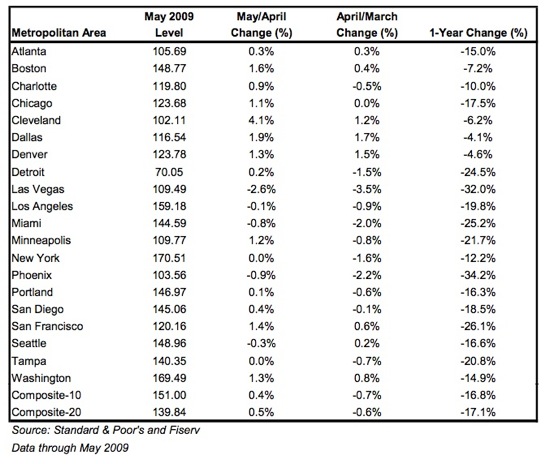S&P: May Home Prices Down -17.1% YOY, 29th Declining Month, 4th Month of Less Decline
The S&P Case Shiller May 2009 report of existing home sales showed year-over-year -17.1% price declines averaged across 20 major metropolitan areas (see table below). Notable declines for the period were Las Vegas -32%, Phoenix -34.2%, and San Francisco -26.1%. Las Vegas and Phoenix are down 54.5% and 53.4% respectively since highs in 2Q2006. From April to May, prices in all 20 cities in the composite were down. Both the 10 and 20 metro area Composites have been in year-over-year decline for 29 consecutive months, and home prices are at similar levels to what they were in mid-2003. From the home price peak in 2Q2006, the 20-City Composite is down 32.6%. The positive news is that May is the fourth consecutive month that the rate of decline has decreased.
Case Shiller May 2009 Home Price Index

The index tracks existing single family homes, and is a credible pricing barometer for broad market analysis because it excludes condos and new construction. Condos can have more volatile pricing, and new construction pricing can be artificially set by builders, especially in times of distress when discounts an incentives can skew pricing. S&P refers to 10 and 20 “City” Composites, but these are actually metropolitan regional areas, not just cities. For example, where the city says San Francisco, this isn’t just San Francisco, but rather the entire 9 county Bay Area region.
FULL TEXT FROM PRESS RELEASE
Data through May 2009, released today by Standard & Poor’s for its S&P/Case-Shiller1 Home Price Indices, the leading measure of U.S. home prices, show that, although still negative, the annual rate of decline of the 10-City and 20-City Composites improved for the fourth consecutive month in 2009.
The chart above depicts the annual returns of the 10-City and 20-City Composite Home Price Indices. The 10-City and 20-City Composites declined 16.8% and 17.1%, respectively, in May compared to the same month last year. These values are improvements over April’s data, which show annual declines of 18.0% and 18.1%, respectively. After 16 consecutive months of record annual declines, beginning in October 2007 and ending in January 2009, the indices have now shown four consecutive months of improvement in annual returns.
“The pace of descent in home price values appears to be slowing” says David M. Blitzer, Chairman of the Index Committee at Standard & Poor’s. “There is a clear inflection point in the year-over-year data, due to four consecutive months of improved rates of return, after the steep decline that began in the fall of 2005. In addition to the 10-City and 20-City Composites, 17 of the 20 metro areas also saw improvement in their annual returns compared to those of April. Looking at the monthly data, 13 of the 20 metro areas reported positive returns; and the 10-City and 20-City Composites reported positive returns for the first time since the summer of 2006. To put it in perspective, these are the first time we have seen broad increases in home prices in 34 months. This could be an indication that home price declines are finally stabilizing”.
“While many indicators are showing signs of life in the U.S. housing market, we should remember that on a year-over-year basis home prices are still down about 17% on average across all metro areas, so we likely do have a way to go before we see sustained home price appreciation.” Mr. Blitzer added.”
The chart above shows the index levels for the 10-City and 20-City Composite Indices. As of May 2009, average home prices across the United States are at similar levels to where they were in the middle of 2003, indicating that the three years of appreciation that occurred from 2003-2006 were all given back in the following three years. From the peak in the second quarter of 2006, the 10-City Composite is down 33.3% and the 20-City Composite is down 32.3%.
In terms of annual declines, the numbers remain relatively somber with all metro areas and the two composites in negative territory, and 16 out of the 20 metro areas are reporting double digit declines. Las Vegas, Los Angeles, Miami, Phoenix, Seattle and Tampa posted their lowest index levels in May since their respective peaks. From peak to trough Phoenix and Las Vegas are the worst off, down 54.5% and 53.4%, respectively. More upbeat news is seen in the monthly data; Dallas and Denver have reported three consecutive months of positive returns. Atlanta, Boston, Cleveland, San Francisco and Washington D.C. each reported two consecutive months of positive returns. Eight of the 13 MSAs reporting positive monthly returns for May were greater than +1.0%.
